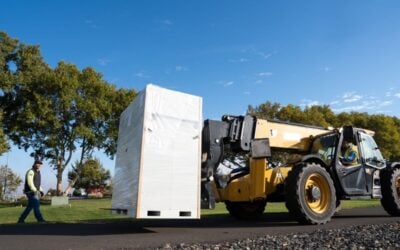SolarEdge’s booth at Intersolar Europe demonstrated how the Tesla battery combines with a household PV system. Image: SolarEdge.
The vice-president for marketing and product strategy at one of only two inverter suppliers to Tesla says it has promised customers that it can “get the battery within six months”.
Lior Handelsman of Israel-headquartered SolarEdge Technologies told PV Tech Storage at the Intersolar Europe show last week that Tesla’s Powerwall residential battery can tie in with any of its range of home inverter and energy management solutions for the European market. The two companies’ US offering, meanwhile, will be based more around providing uninterruptible backup power in case of emergency.
So far, SolarEdge and Austrian company Fronius are the only approved inverter partners for the household version of the US electric vehicle maker’s new stationary storage venture. Tesla is looking for others, the company revealed when hosting the media launch of the storage range at the end of April. Similarly, while SolarEdge has prepared its system to be compatible with Powerwall batteries, Handelsman said the Israeli company will also make it ready for other batteries in the near future.
“What we’ve done in joint development with Tesla is that their battery can tie into our inverter system, for European systems, practically as is,” Handelsman said.
Try Premium for just $1
- Full premium access for the first month at only $1
- Converts to an annual rate after 30 days unless cancelled
- Cancel anytime during the trial period
Premium Benefits
- Expert industry analysis and interviews
- Digital access to PV Tech Power journal
- Exclusive event discounts
Or get the full Premium subscription right away
Or continue reading this article for free
“There’s a small interface box that is very simple, and you can connect the battery to any SolarEdge inverter, including ones that are already installed.”
There has been some speculation as to exactly when the batteries will become commercially available, with Tesla only really saying that Powerwall will be available in selected markets by the end of this year. Handelsman said that while he would not give an exact date either, customers buying SolarEdge inverters today were doing so on the understanding that the Tesla battery will be made available to add to their systems – including retrofits for customers acquired since the Powerwall’s arrival was announced – within six months.
SolarEdge systems complete with inverter, energy management and monitoring systems “will be available in Q4 this year. [The] first markets are US and Europe”.
The company was also launching a range of commercial scale PV inverters at the show last week. Image: SolarEdge.
“
As long as you manage your consumption smart, then you can have power throughout the day and night, and it’s much better than a generator solution, non-polluting, you don’t have to go and get gas, fuel or diesel. It’s a much better solution.
At the show, Handelsman demonstrated to PV Tech Storage how the battery can combine with SolarEdge’s energy monitoring and management hardware and software. As might be expected, it adds the grid-connected battery to SolarEdge’s existing system configuration, which includes inverter, PV array and meter, as well as the power optimisers with which the company made its name that adjust the power output from each PV module on the roof.
Initially, the energy management system will be more relevant to markets in the EU such as Germany, where reduced feed-in tariffs (FiTs) for solar have made self-consumption of on-site generated power the biggest economic driver for households to use PV systems. Most of the US – with a handful of notable exceptions – will be marketed to initially on the basis of providing backup, as net metering policies reward PV owners for feeding their power into the grid rather than using it themselves.
“[Energy management] is more relevant in Europe. For specific places like the Hawaiian market where the grid is congested, reducing feed-in and increasing self-consumption is important but in most of the US market it’s all about backup,” Lior Handelsman said.
“The nice thing is that if the power blackout is more than one day – which can happen after a hurricane or other extreme weather conditions – then the battery will replenish itself from the PV, so the system will continue to work day after day, providing some power to the home.”
With much of the state of New York without power for nearly two weeks after Hurricane Sandy in 2012, it is hoped that this cleaner alternative to diesel generators could take the strain of providing essential power functions in a future catastrophe.
“As long as you manage your consumption smart, then you can have power throughout the day and night, and it’s much better than a generator solution, non-polluting, you don’t have to go and get gas, fuel or diesel. It’s a much better solution.”
According to Handelsman, SolarEdge worked closely with Tesla for around 10 months ahead of the launch. However, one thing he was not willing or perhaps able to divulge was the recipe behind Tesla’s low prices.
“So Tesla obviously did something… what’s the secret sauce? I can’t comment on that.
“Definitely they threw the entire market into turmoil because for everyone here; the benchmark was €1000 (US$1,138) per kWh, then suddenly Tesla came along and said, no the benchmark is €400 per kWh, deal with it!”
A video simulation explaining SolarEdge’s monitoring portal, StorEdge.
“
[Tesla] threw the entire market into turmoil because for everyone here, the benchmark was €1000 (US$1,138) per kWh, then suddenly Tesla came along and said, no the benchmark is €400 per kWh, deal with it!





